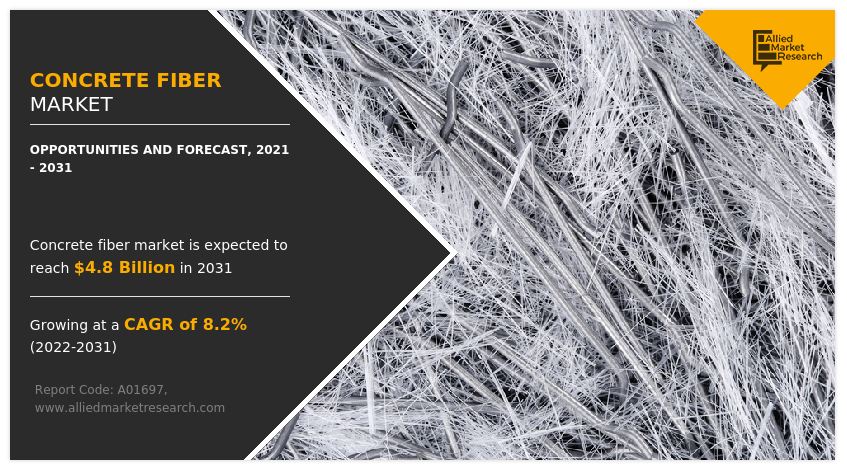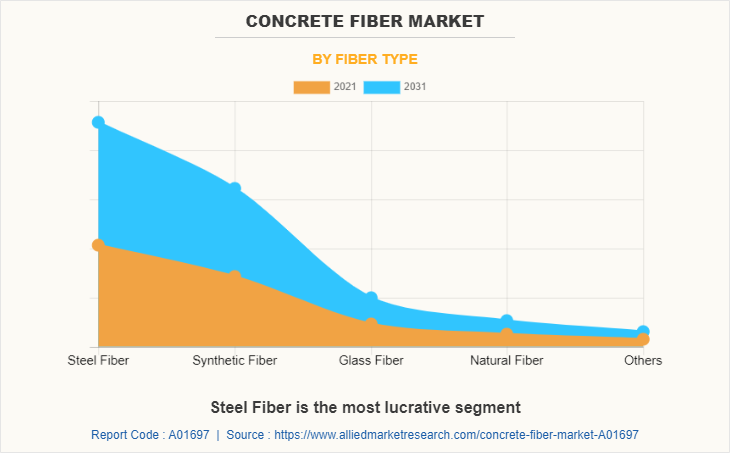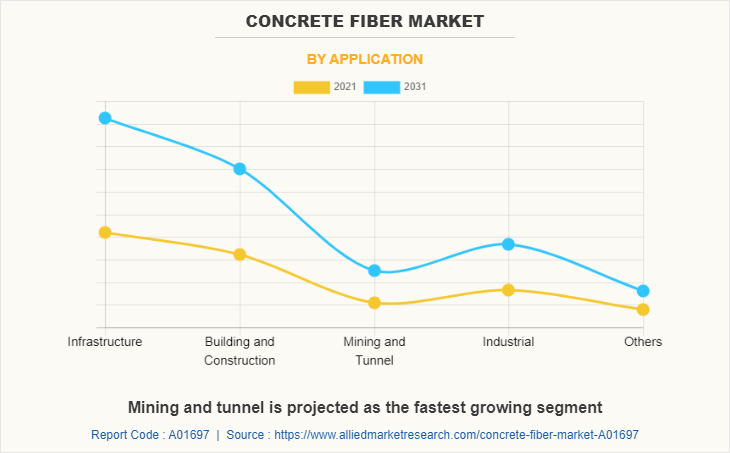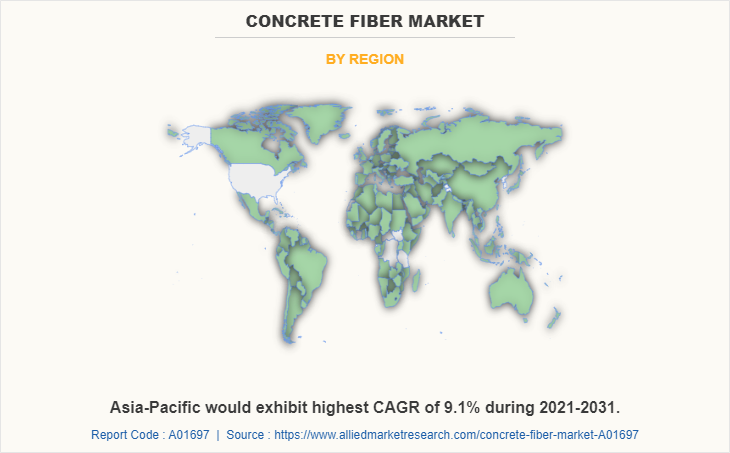Concrete Fiber Market Research, 2031
The global concrete fiber market was valued at $2.2 billion in 2021, and is projected to reach $4.8 billion by 2031, growing at a CAGR of 8.2% from 2022 to 2031.
Report Key Highlighters:
- The concrete fiber market is consolidated in nature among companies such as Sika AG, BASF SE, Bekaert, Kamenny Vek, Nycon, ABC POLYMER INDUSTRIES, ARCELORMITTAL, and GCP Applied Technologies Inc., among others that hold a significant share in the market. Moreover, the report covers the company profiles of 17 companies that are constantly engaged in the production of concrete fiber.
- The study covers both qualitative and quantitative analysis for 19 countries across North America, Europe, Asia-Pacific, and LAMEA regions.
- Latest trends such as the development of synthetic fiber-reinforced concrete fiber by key manufacturers across various regions and its applications in various end-use sectors such as mining, building & construction, and others have been covered in the report that provides upcoming opportunities in the concrete fiber market.
- Furthermore, the report also covers the key regulation analysis of the concrete fiber market across North America, Europe, Asia-Pacific, and LAMEA regions. It provides in-depth knowledge of acts and regulations imposed by various governments for manufacturing and sales of concrete fiber worldwide.

Fiber-reinforced concrete or concrete fiber is a composite material made up of steel fiber, synthetic fibers, glass fibers, and natural fibers. This type of concrete enhances the shear capacity of reinforced concrete beams and improves fatigue strength.
Growing population base has led to rapid urbanization in both developed and developing economies such as the U.S., China, India, and others. This has increased government spending on the building & construction sector to develop various upcoming infrastructure projects. For instance, according to a report published by the National Investment Promotion and Facilitation Agency, infrastructure activities accounted for 13% share of the total foreign direct investment (FDI) inflows in 2021. Furthermore, rapid development of mining and metro tunnels, airports, schools, and hospitals are aiding the growth of the building & construction sector.
Concrete fiber is used in mining and tunnel applications for improving concrete strength and durability, shock & fatigue resistance, and other characteristics. It is used in tunnel linings and subways to redistribute the forces within the concrete structure. The increasing demand for minerals and mining metals has surged the mining activities where concrete fiber is widely used to resist crack formation in concrete structures. In addition, traffic congestion has led the government of both developed and developing economies to build tunnels and subways where concrete fiber is used to redistribute loads in tunnel linings.
Moreover, concrete fiber is widely used to reduce crack formation in concrete materials. Moreover, rapid industrialization has surged the set-up of industries in both developed and developing economies where concrete fiber is used for enhancing the tensile strength of industrial structures. In addition, governments of different countries are consistently focusing on infrastructure development where concrete fiber is used to redistribute the load, enhance tensile strength, and prevent cracks. These factors together are anticipated to increase the sales of concrete fiber among the building and construction sectors; thus, fueling the market growth.
Moreover, concrete fiber is used in industrial structures to provide additional support by enhancing tensile strength, load-bearing capacity, reducing air voids, and others. It is used in beams, pliers, and foundations to resist crack formation by uniformly distributing the load. Rapid industrialization in countries such as the U.S., China, India, and others, have surged the demand for concrete fiber used to enhance the tensile strength and load-bearing capacity of industrial structures.
Fiber-reinforced concrete possesses more tensile strength as compared to non-reinforced concrete. It enhances concrete durability, impact strength, and reduces crack growth. These factors make concrete fiber more expensive as compared to non-reinforced concrete or plain concrete. Furthermore, adding fibers to concrete makes it heavier and requires more structural support for the construction project. Also, concrete fiber is not suitable for construction projects where the overall weight of the building structure needs to be less. These factors altogether have led the customers or construction projects to use plain (non-reinforced) concrete over concrete fiber; thus, hampering the growth of the concrete fiber market.
In addition, micro synthetic and macro-synthetic fiber can be reinforced with concrete to achieve a high level of performance. In addition, deformed macro synthetic fiber can be reinforced with concrete to achieve improved toughness, ductility, impact resistance, and minimal cracking risk. Other factors such as surface durability, minimal maintenance cost, and improved shatter resistance make synthetic fiber reinforced concrete the best-suited material for pavement construction. Use of synthetic fiber reinforced concrete for flooring application is the key market trend. In addition, it can also be used during construction of internal ground structures that are supported on floor slabs.
Other applications of synthetic fiber reinforced concrete include all-purpose industrial flooring, power floated flooring, flooring of garages, workshop flooring, and domestic use flooring. Synthetic fiber reinforced concrete can also be used for pavement construction, and for the construction of external ground supported slabs. This factor is expected to offer remunerative opportunities for the concrete fiber market in the future.
The concrete fiber market is segmented on the basis of fiber type, application, and region. On the basis of fiber type, the market is categorized into steel fiber, synthetic fiber, glass fiber, natural fiber, and others. The applications covered in the study include infrastructure, building & construction, mining & tunnel, industrial, and others. Region wise, the market is studied across North America, Europe, Asia-Pacific, and LAMEA.
The major companies profiled in this report include Sika AG, Cemex S.A.B. de C.V., Ozinga Bros., Inc., HeidelbergCement, TUF-BAR, BarChip Pty Ltd, BASF SE, Bekaert, Kamenny Vek, Nycon, Euclid Chemical Company, Forta Concrete Fiber, ABC Polymer Industries, ArcelorMittal, GCP Applied Technologies Inc., Owens Corning, RPM International Inc.

The synthetic fiber concrete fiber market size is projected to grow at the highest CAGR of 8.5% during the forecast period and accounted for 32.7% of concrete fiber market share in 2021. Use of synthetic fiber reinforced concrete for flooring application is the key market trend. In addition, it can also be used during construction of internal ground structures that are supported on floor slabs. Other applications of synthetic fiber reinforced concrete include all-purpose industrial flooring, power floated flooring, flooring of garages, workshop flooring, and domestic use flooring. Synthetic fiber reinforced concrete can also be used for pavement construction, and it can be used for construction of external ground supported slabs.
Moreover, roadways, farmyards, and domestic driveways are some of the other examples that can be constructed with the use of synthetic fiber reinforced concrete. All these factors are driving the demand for concrete reinforced with synthetic fiber thereby augmenting the global demand.

In 2021, the infrastructure segment was the largest revenue generator, and is anticipated to grow at a CAGR of 8.2% during the forecast period. The increasing highway construction in countries such as China, India, and others, where concrete fiber is used to prevent cracks and enhance the load bearing capacity of highways may fuel the market growth. For instance, according to a report published by India Brands Equity Foundation in 2022, highway construction in India increased at a CAGR of 17.00% from 2016 to 2021. In addition, increasing impetus to develop infrastructure has attracted several domestic and international investments in the sector. This is projected to boost the growth of the concrete fiber market for infrastructure application.

By region, the Asia-Pacific segment dominated the global market in 2021, and is anticipated to grow at a CAGR of 9.1% during forecast period. The rising building & construction sector has enhanced the performance of the concrete fiber market in the Asia-Pacific region. Countries such as China, India and Australia are witnessing a rapid increase in transportation sectors which in turn has surged the construction of highways, link roads, bridges, high-speed railway tracks, inland waterways structures, and others, where concrete fiber is used to provide structural integrity and reduce cracking due to plastic shrinkage. For instance, according to a report published by the Indian Ministry of Commerce and Industry, the transportation sector in India is expected to grow at a compound annual rate (CAGR) of 5.9% owing to the development of highways, widespread railway networks, aviation ports, and waterways structure. This is expected to enhance the performance of the concrete fiber market in the Asia-Pacific region.
In addition, the rise in residential and commercial building & infrastructure projects in countries such as India and Japan where concrete fiber is widely used to provide structural integrity to building structures, is expected to fuel the market growth. For instance, according to a report published by National Investment Promotion and Facilitation Agency of India, the construction output in India is expected to grow on an average of 7.1% each year and is projected to emerge as the third-largest industry by 2025. This is anticipated to enhance the sales of concrete fiber in the Asia-Pacific region.
IMPACT OF COVID-19 ON THE GLOBAL CONCRETE FIBER MARKET
- Moreover, the construction sector accounted for 7.7% of global employment in 2021 and it was projected to reach 13.4% by 2022. However, the current pandemic situation has created stress among workers and the downfall in the revenue from the construction & building sector has impacted negatively on this sector. All these factors have indirectly affected the production and supply of concrete fiber that are used in building & construction end-use.
- However, emerging geographic scenarios enhanced the domestic supply chain, and strong public investments are projected to drive the growth of the concrete fiber market. For instance, according to an interim report for the 2021 Australian infrastructure plan, the Australian Construction Industry Forum (ACIF) expects the construction industry to return to pre-COVID-19 levels by 2022-23, driven by strong public investments. This is predicted to boost the growth of the concrete fiber market post-COVID-19 period.
KEY BENEFITS FOR STAKEHOLDERS
- This report provides a quantitative analysis of the market segments, current trends, estimations, and dynamics of the concrete fiber market analysis from 2021 to 2031 to identify the prevailing concrete fiber market opportunities.
- Market research is offered along with information related to key drivers, restraints, and opportunities.
- Porter's five forces analysis highlights the potency of buyers and suppliers to enable stakeholders to make profit-oriented business decisions and strengthen their supplier-buyer network.
- An in-depth analysis of the concrete fiber market segmentation assists to determine the prevailing market opportunities.
- Major countries in each region are mapped according to their revenue contribution to the global market.
- Market player positioning facilitates benchmarking and provides a clear understanding of the present position of the market players.
- The report includes an analysis of the regional as well as global concrete fiber market trends, key players, market segments, application areas, and market growth strategies.
Concrete Fiber Market Report Highlights
| Aspects | Details |
| Market Size By 2031 | USD 4.8 billion |
| Growth Rate | CAGR of 8.2% |
| Forecast period | 2021 - 2031 |
| Report Pages | 437 |
| By Fiber Type |
|
| By Application |
|
| By Region |
|
| Key Market Players | HeidelbergCement, EUCLID CHEMICAL COMPANY, TUF-BAR, FORTA CONCRETE FIBER, Sika AG, BarChip Pty Ltd, ARCELORMITTAL, Kamenny Vek, OZINGA BROS., INC., RPM International Inc., ABC POLYMER INDUSTRIES, Cemex S.A.B. de C.V., Owens Corning, BASF SE, Bekaert, GCP Applied Technologies Inc., Nycon |
Analyst Review
According to CXOs of leading companies, the global concrete fiber market is expected to exhibit high growth potential owing to its use in applications such as infrastructure, building & construction, and mining & tunnel. Concrete fiber is used in mining and tunnel applications for improving concrete strength and durability, shock & fatigue resistance, and other characteristics. It is used in tunnel linings and subways to redistribute the forces within the concrete structure.
The increasing demand for minerals and mining metals has surged the mining activities where concrete fiber is widely used to resist crack formation in concrete structures. This is expected to be among the key drivers for the growth of the concrete fiber market. In addition, traffic congestion has led the government of both developed and developing economies to build tunnels and subways where concrete fiber is used to redistribute loads in tunnel linings. Railways, highway construction, and industrial sectors that require greater impact, abrasion, and shatter resistance in concrete can be accomplished with concrete fiber. CXOs further added that sustained economic growth and development of the building & construction sector have increased the popularity of concrete fiber
The use of synthetic fiber-reinforced concrete for flooring applications is one of the key market trends. In addition, it can also be used during construction of internal ground structures that are supported on floor slabs.
The infrastructure segment was the largest revenue generator and is anticipated to grow at a CAGR of 8.2% during the forecast period.
The Asia-Pacific segment dominated the global market in 2021, and is anticipated to grow at a CAGR of 9.1% during forecast period.
The concrete fiber market is estimated to reach $4.8 billion by 2031, exhibiting a CAGR of 8.2% from 2022 to 2031.
The major companies profiled in this report include Sika AG, Cemex S.A.B. de C.V., Ozinga Bros., Inc., HeidelbergCement, TUF-BAR, BarChip Pty Ltd, BASF SE, Bekaert, Kamenny Vek, Nycon, Euclid Chemical Company, Forta Concrete Fiber, ABC Polymer Industries, ArcelorMittal, GCP Applied Technologies Inc., Owens Corning, RPM International Inc.
Loading Table Of Content...



